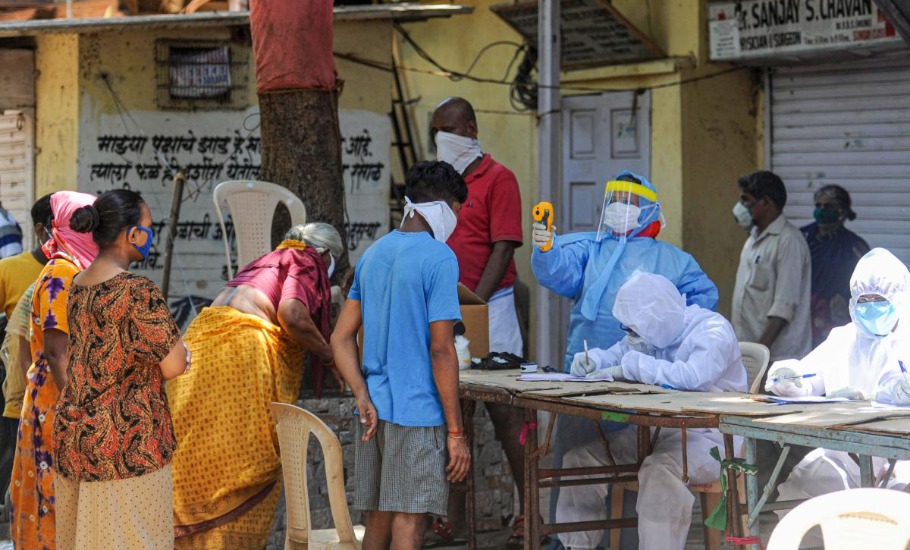
Dharavi flattens COVID-19 curve even before Mumbai. Know how
Dharavi is now a success story! The densest slum of the country and a COVID-19 hotspot in the heart of Mumbai, it has managed to flatten the curve of the deadly infection even before the financial capital could do it.

Dharavi is now a success story! The densest slum in the country and a COVID-19 hotspot in the heart of Mumbai, it has managed to flatten the curve of the deadly infection even before the financial capital could do it.
It was considered to be the most vulnerable spot which would only add to the alarming rise of cases in Mumbai. However, Dharavi managed to turn around the situation, becoming an example for urban slums struggling to contain the pandemic.
Door-to-door surveillance, institutional quarantine of the vulnerable population and roping in private players were the key aspects of Dharavi’s fight against COVID-19.
Related news: BMC de-seals Dharavi’s first containment zone as cases touch 1,145
The slum reported a total of 491 cases in April and 1,216 in May, while in June, it has come down to only 274 cases so far, according to the Brihanmumbai Municipal Corporation (BMC) data. The doubling rate has reached 79 days from 43 in the last month, while growth rate has dropped to just 1.05 per cent in June from 12 per cent in April, the data revealed.
Vulnerable Dharavi
Dharavi is Asia’s largest slum spread over an area of around 2.1 sq km, housing over seven lakh people. In this crammed locality, most of the houses measuring around 100 sq ft host about 5-10 residents; and this number is even higher in some places. Almost everyone uses public toilets, thus making the locality the most vulnerable part of the city for the spread of the virus.
The Federal had earlier reported how space crunch and the failure in maintaining social distancing norms could act as a constraint in the fight against the pandemic.
A reverse trend
While the number of COVID-19 cases across the country is constantly on the rise, Dharavi is showing a reverse trend. The number of new daily cases has come down to a third of what it was in May, i.e. on an average, 18 new cases are now being reported everyday as compared to around 50 in May.

More than half of the patients have recovered while the number of deaths too has declined in the month of June. So far, Dharavi has reported a total of 2,068 cases, of which 1,040 have been discharged. The death toll stands at 77, as of June 15.
Mission Dharavi
“We chased the virus instead of letting it spread across the slum,” said Kiran Dighavkar, Assistant Commissioner, G North-ward, Mumbai, who is spearheading the battle against COVID-19 in Dharavi.
Back in April, he had embarked on the strategy called ‘Mission Dharavi’ wherein he had roped in a team of more than 2,000 people to contain the spread of the virus. The team comprised doctors, engineers, healthcare professionals, and sanitation workers.
Dighavkar further said, “Social distancing was just impossible in there. So the only option we had was to chase the virus itself.”
Related news: From vegetable kits to ration coupons: Pune slum keeps virus at bay
Accordingly, the officials carried out a door-to-door survey in more than 47,000 houses since April. Apart from body temperature, the screening process also included testing of oxygen levels in blood. This is how the vulnerable population was separated. The main aim was to control the potential number of deaths, said Dighavkar.
Later, the BMC administration asked people to come forward and get themselves screened in private clinics in and around Dharavi. This made the task easier. This way, many people were quarantined at a very early stage in government quarantine facilities that helped curb the spread and reduce mortality. Also, symptomatic patients were tested at an early stage.

Five private hospitals were taken over to treat those in need of critical care. The BMC also conducted around 7,000 tests as on date, while an additional 2,000 tests were conducted by private laboratories, informed Dighavkar.
Rajiv Gandhi Sports Complex and municipal schools in Mahim area were converted into large scale quarantine facilities. These facilities housed more than 8,500 people until June.
Related news: Death of Mumbai patient fuels fear of COVID-19 spread in Dharavi slum
In some instances, people voluntarily quarantined themselves in government facilities once they developed symptoms. The civic body also arranged yoga and pranayam sessions for the asymptomatic patients in quarantine facilities.
“The early action helped us curb the spread,” said Dighavkar.
Though the challenge still remains, the slum has managed to flatten the curve at a very early stage, compared to the city or even the country.


